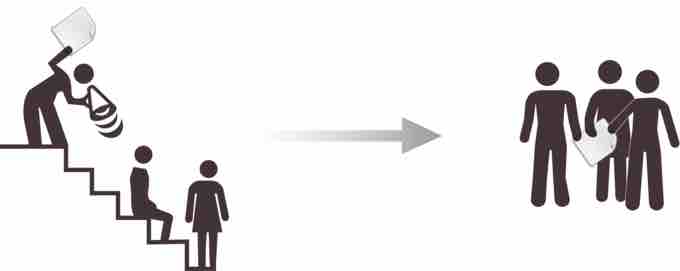Decentralization is the process of dispersing decision making authority among the people, citizens, employees, or other elements of an organization or sector. In decentralized structures, responsibility for decision making and accountability are broadly dispersed down to the lower levels of an organization. This dispersion can be intentional or unintentional. A decentralized organization tends to show fewer tiers in its organizational structure (less hierarchy), a wider span of control, and a bottom-to-top or horizontal flow of decision making and ideas.

Decentralization
The management structure in a decentralized organization changes from a top-down approach to more of a peer-to-peer approach.
Contrasting Centralized and Decentralized Structures
In a centralized organization, decisions are made by top executives on the basis of current policies. These decisions or policies are then enforced through several tiers of hierarchy within the organization, gradually broadening the span of control until they reach the bottom tier.
In a decentralized organization, the top executives delegate much of their decision making authority to lower tiers of the organizational structure. This type of structure tends to be seen in organizations that run on less rigid policies and wider spans of control among each officer of the organization. The wider spans of control also reduce the number of tiers within the organization, giving its structure a flat appearance .

Decentralized organizational chart
This image illustrates a decentralized (often referred to as a "flat") organizational chart. Note that there are not multiple layers of management; there is one manager and then the rest of the staff. This means that each staff-person necessarily has more responsibility and therefore more autonomy.
Advantages of Decentralization
One advantage of this structure—if the correct controls are in place—is the bottom-up flow of information. This flow allows lower-level employees to better inform the officials of the organization during any decision making processes. For example, if an experienced technician at the lowest tier of an organization knows how to increase the efficiency of the production, the bottom-to-top flow of information can allow this knowledge to pass up to the executive officers.
Disadvantages of Decentralization
On the other side of the argument, when companies decentralize authority there can be confusion as to how final decisions are made. It can be difficult to empower multiple people without certain decisions negatively interacting with other decisions. Decentralized organizations must be mindful of the possibility of running in too many different directions at once. Because of this, decentralization is most effective in organizations that have transparent strategies, a strong mission, and a clear vision.